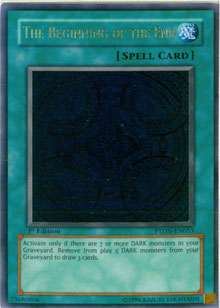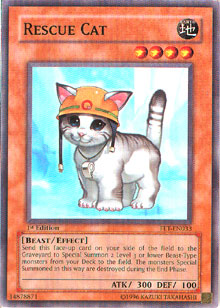 If there’s one thing I know for sure about the state of the game post-Phantom Darkness, it’s that duels have the possibility of going very fast. The Beginning of the End has been framed as one of the "slowest" cards in the set because you need seven Dark monsters in the graveyard to activate it. The thing is, the requirement of seven Dark monsters is nearly as easy to achieve as having any five monsters in your graveyard for Pot of Avarice. Thanks to Phantom Darkness, those requirements are nothing to a properly constructed deck. Between Armageddon Knight, Dark Grepher, and Magical Merchant, the graveyard can be loaded for The Beginning of the End in about three turns, regardless of interference from Raiza the Storm Monarch and Phoenix Wing Wind Blast. That’s some serious speed, but it’s also a deck for another time. This week, I want to take a look at what a few new non-PTDN cards can do to breathe new life into one of my all-time favorite decks from the Yu-Gi-Oh! GX era, Crystal Beasts.
If there’s one thing I know for sure about the state of the game post-Phantom Darkness, it’s that duels have the possibility of going very fast. The Beginning of the End has been framed as one of the "slowest" cards in the set because you need seven Dark monsters in the graveyard to activate it. The thing is, the requirement of seven Dark monsters is nearly as easy to achieve as having any five monsters in your graveyard for Pot of Avarice. Thanks to Phantom Darkness, those requirements are nothing to a properly constructed deck. Between Armageddon Knight, Dark Grepher, and Magical Merchant, the graveyard can be loaded for The Beginning of the End in about three turns, regardless of interference from Raiza the Storm Monarch and Phoenix Wing Wind Blast. That’s some serious speed, but it’s also a deck for another time. This week, I want to take a look at what a few new non-PTDN cards can do to breathe new life into one of my all-time favorite decks from the Yu-Gi-Oh! GX era, Crystal Beasts.
One of the biggest issues with the Crystal Beast deck is that drawing Crystal Beast Sapphire Pegasus is absolutely vital to achieving the thresholds required to use the most potent effects available to a Crystal Beast player. One copy of Pegasus is basically equivalent to getting two Crystal Beasts into the spell and trap zone provided that your opponent destroys the Pegasus rather than spinning it to the top of your deck. If the opponent does spin it to the top of your deck, it basically gives you the equivalent of yet another Crystal Beast in your spell and trap zone since you’ll just re-summon the Pegasus again next turn.
The problem is that Crystal Beast Sapphire Pegasus only makes up three out of the 40 cards in your deck, and you aren’t going to get it first turn every game. It’s the same problem that Counter Fairy decks tend to face regarding Bountiful Artemis, but an increasing number of solutions have been arriving, one after another. The first and most generic is the World Championship 2008 video game promo, Deep Diver. The Diver can get you any monster you want if it’s destroyed in battle and sent to the graveyard, with the caveat that the monster has to go on top of your deck. It’s not the most ideal solution in the world, but it does work, especially if you can speed it along even further. This is where Duelist Pack - Jesse Anderson comes into play. You see, if there’s anything better than being allowed to have three copies of Crystal Beast Sapphire Pegasus in your deck, it’s having the potential to create another three copies of Pegasus out of any other Crystal Beast you might control. I think it would look a little something like this:
I’m pretty sure that at this point, the above lineup of Crystal Beasts is generally considered the most useful and productive outside of a deck centered on Rainbow Dragon. Even then, the Rainbow Dragon deck would probably just replace two of the Amethyst Cats with Emerald Tortoise and Cobalt Eagle before changing the rest of the deck around to reflect the difference in strategy. Pound for pound, this is the lineup of Crystal Beasts that I’ve found to be the most effective since Force of the Breaker was released, because it has the best combination of offensive power and ability to build infrastructure available.
 The strategy here is, as expected, to control the game with Ancient City - Rainbow Ruins until you’re ready to drop Crystal Abundance for the win. I’ve thought quite a bit about Crystal Abundance lately and why people seem to hesitate before including it as a definite win condition for the deck. First and foremost, people are afraid of Dark Bribe and Solemn Judgment. These cards were a lot more prevalent a few months ago, but they definitely scared a number of people away from Crystal Abundance and, in fact, the deck as a whole. Now, Bribe and Judgment are back in a big way, and they further augment the second and more relevant problem to the Crystal Beast player: Macro Cosmos. It’s a pretty horrible feeling to go into a tournament knowing that you have a hideously bad matchup that for all intents and purposes seems unwinnable. The thing is, Crystal Beasts actually get around more of the Cosmos decks’ tricks than it first appears.
The strategy here is, as expected, to control the game with Ancient City - Rainbow Ruins until you’re ready to drop Crystal Abundance for the win. I’ve thought quite a bit about Crystal Abundance lately and why people seem to hesitate before including it as a definite win condition for the deck. First and foremost, people are afraid of Dark Bribe and Solemn Judgment. These cards were a lot more prevalent a few months ago, but they definitely scared a number of people away from Crystal Abundance and, in fact, the deck as a whole. Now, Bribe and Judgment are back in a big way, and they further augment the second and more relevant problem to the Crystal Beast player: Macro Cosmos. It’s a pretty horrible feeling to go into a tournament knowing that you have a hideously bad matchup that for all intents and purposes seems unwinnable. The thing is, Crystal Beasts actually get around more of the Cosmos decks’ tricks than it first appears.
One of the biggest rules clarifications to come out of Nationals 2007 (and also probably the least known) is the question of what happens if someone tries to play Crystal Abundance while Dimensional Fissure is in play. A similar rule was needed to determine whether you could use Card Trooper’s effect while Dimensional Fissure is in play. The short answer is that you can’t because there’s no guarantee that you’ll be sending non-monster cards to pay the cost of Card Trooper’s effect. Things are a bit different with Crystal Abundance, though. While it might seem that you wouldn’t be allowed to activate it with Fissure in play, the fact that they’re treated as spells instead of monsters while they’re in your spell and trap zone allows you to send them to the graveyard with no interference from Dimensional Fissure. Of course, Macro Cosmos screws all that up, but if there’s a catch-all answer to Macro Cosmos, Dark Bribe, and Solemn Judgment (assuming you can get it past Judgment), it’s Jinzo. Jinzo is an absolute natural in a deck with no traps, and so I’m running the max allowed in this deck.
 Let’s say that we’ve gotten past the opponent’s ability to actually counter Abundance or prevent us from playing it. That doesn’t solve the speed issue. The Jesse Anderson Duelist Pack, on the other hand, does. First, you can just tear through the deck faster than you used to be able to thanks to the quick-play spell, Hand Destruction. Sure, it helps your opponent out, but it also loads your graveyard with Crystal Beasts that you didn’t have any intention of spending your normal summon on, like that third copy of Amethyst Cat, a potentially dead Rescue Cat, or basically anything you don’t need at the time. It’s a lot faster than Rare Value and it doesn’t disrupt your infrastructure, making it that much easier to win the game on the turn you play it and rendering the benefit to your opponent a moot point.
Let’s say that we’ve gotten past the opponent’s ability to actually counter Abundance or prevent us from playing it. That doesn’t solve the speed issue. The Jesse Anderson Duelist Pack, on the other hand, does. First, you can just tear through the deck faster than you used to be able to thanks to the quick-play spell, Hand Destruction. Sure, it helps your opponent out, but it also loads your graveyard with Crystal Beasts that you didn’t have any intention of spending your normal summon on, like that third copy of Amethyst Cat, a potentially dead Rescue Cat, or basically anything you don’t need at the time. It’s a lot faster than Rare Value and it doesn’t disrupt your infrastructure, making it that much easier to win the game on the turn you play it and rendering the benefit to your opponent a moot point.
The other big addition to the Crystal Beast arsenal is Crystal Release, probably the most unsung card of the Crystal Beast theme simply because it’s got the equip symbol on it. Let me ask you something. When was the last time the equip spell symbol stopped Premature Burial from being game-breaking or Snatch Steal from being so good it’s Forbidden? Exactly. You may need a Crystal Beast in play already to lay down Crystal Release, but once you do, it turns that monster into another copy of Sapphire Pegasus (albeit a delayed one). You won’t get the extra Crystal Beast until Release is somehow sent to the graveyard, but how that happens is irrelevant. It could go because the equipped monster is destroyed (and crystallized!) or because the equipped monster was spun back to the top of the deck or even because of Heavy Storm.
Actually, Crystal Release makes cards with field-wiping abilities fear its presence in a new and exciting way if you have Ancient City - Rainbow Ruins and at least one Crystal Beast in the zone already. If you do, the field clearer won’t be able to take away City, and when Crystal Release and the Crystal Beast are destroyed, one will go to the zone and the other will go to the graveyard—prompting you to grab another Crystal Beast from the deck. Demise hates it when that happens as it’ll allow you to halve some of the massive damage that usually heads your way afterward . . . unless the opponent still has enough life to pay for another field clear from Demise.
Crystal Release also helps you make a dent in the opponent’s life points faster by offering an 800 ATK boost to the Crystal Beast you equip it to. That brings Mammoth up to 2500 ATK, Topaz Tiger up to 2400 or 2800 (depending on whether he’s attacking or defending), Pegasus up to 2600, and Amethyst Cat up to 2000 ATK! A kitty that big can scratch your opponent for 1000 a turn or take out most level 4 or lower monsters. It’s serious business no matter how you break it down, and it’s just one of the many potent weapons that the Crystal Beast deck can now offer you.
That’ll do for this week, but be sure to come back next week when I go back to breaking Phantom Darkness in half . . . as if it needed the help. Until next time, play hard, play fair, and most importantly, have fun!
-Jerome McHale